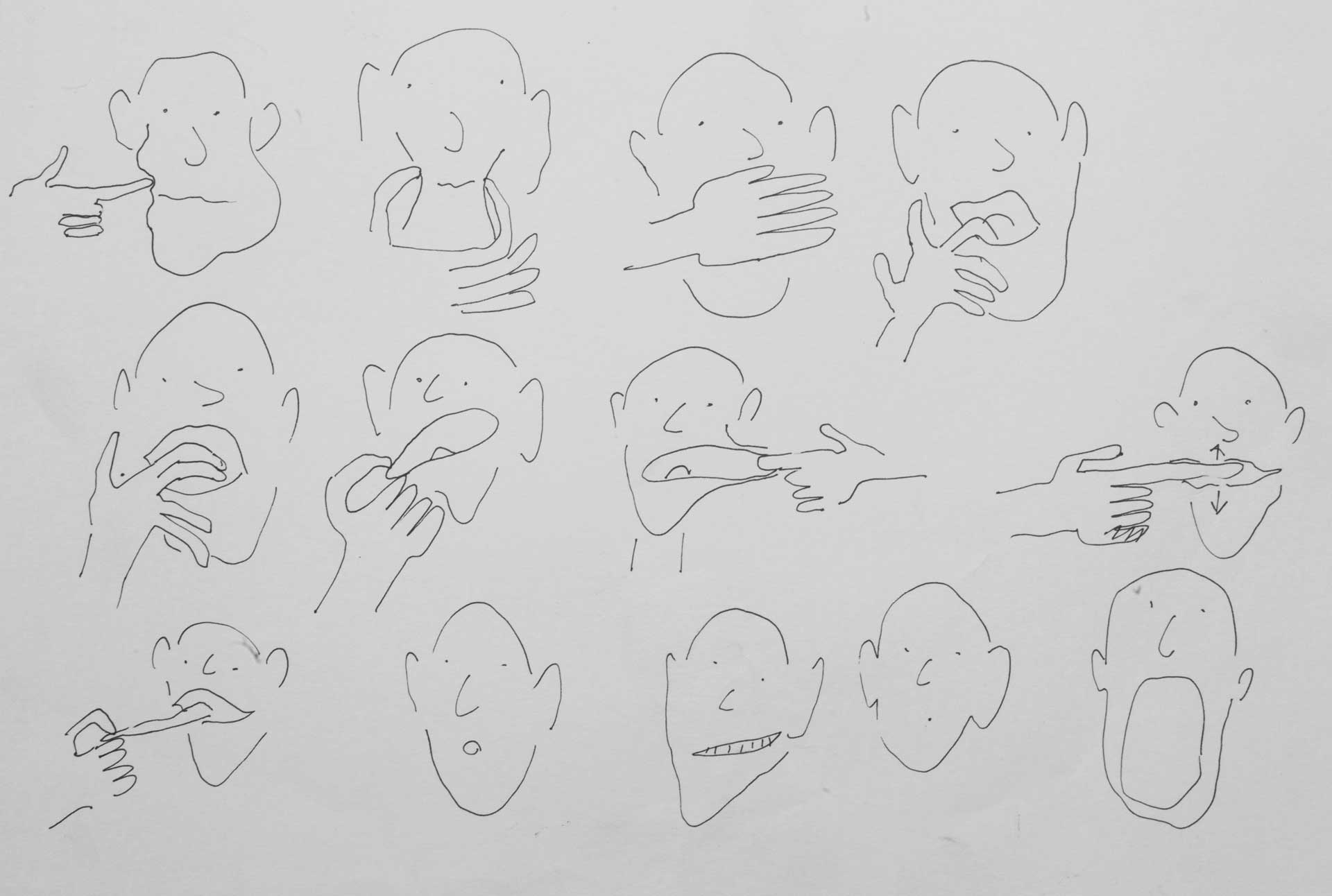The Mouth
On the reconstruction of spoken language, for voice, two bass clarinets, tuba, pre-recorded sound.
Composition
2004
Catalogue number : 10
The work « The Mouth » for voice, two bass clarinets, tuba, cello and tape features a more complex relationship between listening, speaking and interpreting. Rather than using the material of an arbitrary conversation, Bosetti chose the phrase, « What do we want to talk about? Let’s talk about our mouths ». The conversation was played to the musicians of KNM Berlin with the request that they imitate it as closely as possible on their instruments. The third step led Bosetti back to the speech-impaired persons, who in turn tried to copy the instrumental sounds. The acoustic material obtained in this way was processed on the one hand in the playback tape for « The Mouth ». On the other hand, it is played to the musicians via headphones during the live performance and thus functions as an acoustic score.
Bosetti sees in this procedure a way of not turning into the dead end of deconstructing language and thus finds a very personal, poignant style.
« I composed a “headphones score” for four players (cello, bass clarinets, tuba) and a vocalist exclusively made of sounds from voices of handicapped persons. During the piece they have to imitate the sounds they hear, as precisely as they can. They are like dolmetchers. During the piece some elements of the “headphones score” are revealed through the electroacoustic part of the composition although many other remain hidden. The piece was carried out together with the Kammerensemble Neue Musik in Berlin. »
The starting point is Alessandro Bosetti’s « The Mouth ». The subtitle – On the reconstruction of spoken language – points to a counter-design to the path of musical deconstruction of language often taken in the last century. This began with the sound poets of the early avant-garde and led through important works of modernism (e.g. Berio’s « Theme (Omaggio a Joyce) » to Phil Minton’s vocal art. It seemed that fragmentation and deformation was the only proven way to integrate language into the musical context. The Italian composer, saxophonist and sound artist Alessandro Bosetti asked himself if the opposite way was not possible, namely that of a landscape of broken words into a renewed musical metalanguage. For this reason Bosetti began to meet with speech impaired people such as spastics, laryngectomists or aphasics from Italy and Germany, who have suffered from these diseases since childhood and from time to time have to reconstruct their deconstructed language nevertheless in everyday life. In these very empathetically conducted meetings, Bosetti recorded the interviews. He played examples from sound art, new and improvised vocal music via headphones during the meetings and recorded the reactions of his interlocutors with the tape recorder.
Bosetti processed this documentary, quasi-naturally deconstructed material along musical lines, and in 2003 completed his radio piece « Il Fiore della Bocca » in the studio, commissioned by DeutschlandRadio, in which every single sound was extracted from the original interview.
Premiered
20.00 Uhr
Werner-Otto-Saal
Clang•Cut
schroff / zerschnitten: 4 Arbeiten am Klang
Programm
Alessandro Bosetti
The Mouth (UA)
On the reconstruction of spoken language
Martin Brandlmayr
Manuel Modes (UA)
Richard Barrett
Codex VI (UA)
Andrea Neumann/Ana Maria Rodriguez/Steffi Weismann
Scrap (UA)
Andrea Neumann, Komposition/Inside piano
Ana Maria Rodriguez, Komposition/Live-Elektronik
Steffi Weismann, Video/Live-Video
Richard Barrett, Komposition/Live-Elektronik
Alessandro Bosetti, Komposition/Klangregie
Martin Brandlmayr, Percussion/Live-Elektronik
Ute Wassermann – Stimme
Christian Kesten – Stimme
Thomas Bruns – Klangregie
Kammerensemble Neue Musik Berlin
Winfried Rager, Klarinette/Bassklarinette; Theo Nabicht, Saxophon/Bassklarinette; Robin Hayward, Tuba; Ekkehard Windrich, Violine; Ringela Riemke, Violoncello
Ein Projekt der Künstlergruppe Clang•Cut in Kooperation mit dem KNM Berlin und dem Konzerthaus Berlin, ermöglicht durch den Hauptstadtkulturfonds, mit freundlicher Unterstützung der Senatsverwaltung für Wissenschaft, Forschung und Kultur.
Clang•Cut
Das Bild, das den genialen Künstler mit seinem originären Kunstwerk zeigt, ist längst zerkratzt. Kleine Haarrisse durchziehen es und lassen beim genauen Betrachten ein Mosaik entstehen, das die Einheit des Bildes in Frage stellt.
Dieser Blick ins Detail ist der gemeinsame Nenner des Projektes Clang•Cut – nicht nur für die Mitwirkenden selbst. Auch das Publikum kann erleben, wie ein Werk durch ein Netz verschiedener künstlerischer Einflussnahmen in Echtzeit generiert, transformiert und interpretiert wird. Das Bild einer Werkstatt drängt sich auf, in der gemeinsam, hartnäckig und besessen am Klang gewirkt wird. Diese Arbeit am Klang, in der die Künstler auch ihre bürgerlichen Identitäten vom Komponisten zum Interpreten, vom Interpreten zum Improvisator wechseln, ist faszinierend und weitet sich bis in Visuelle aus.
Clang•Cut, der schroffe, zerschnittene Klang, steht so als programmatischer Titel für künstlerische Haltungen, die sich radikal dem Klang/Bild im Detail und damit den kleinsten musikalischen und visuellen Einheiten widmen. Diese bilden den Ausgangspunkt, denn die Demontage hat bereits durch die Auswahl der dokumentarischen Klänge, den Einsatz dekonstruierter Instrumente und die Klangbearbeitung im Studio stattgefunden.
Im Zentrum von Clang•Cut stehen so vor allem synthetisierende künstlerische Prozesse wie Montage und Rekonstruktion, die in netzwerkartigen Schaltungen oder verflochtenen Konstellationen aus Komponist und Interpret verlaufen. Synthetisiert wird vor den Ohren und Augen des Publikums in Echtzeit – bei keiner der bei Clang•Cut vorgestellten Arbeiten handelt es sich um Aufzeichnungen vorangegangener Operationen oder um die Wiedergabe genau fixierter Strukturen. Die Bedingungen des Momentes, des Ortes und der Mitwirkenden, also der Kontext, wird zu einem wichtigen Katalysator.
Legt der Betrachter die Lupe jedoch wieder beiseite, liest er die großen Konturen: er findet vier Werke innerhalb von Clang•Cut vor, die ihren Namen, ihren Autor haben und durch unterschiedliche Materialien, Ideen und Konzepte überzeugen.
